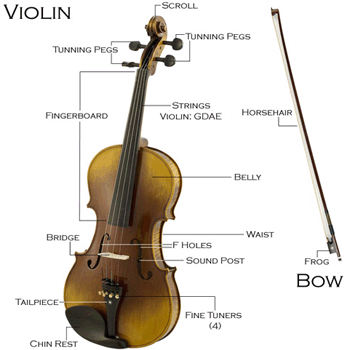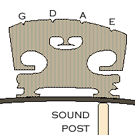Product Description

From the Manufacturer
All of our violins are handcrafted instruments that are tested at our factory and inspected again by skilled technicians at our Los Angeles distribution center prior to shipping. Please read the setup and tuning instructions carefully after receiving the violin. It will help you understand how to set up and tune the violin.
Violin Owner’s Manual
Exposure to sudden changes in temperature and humidity can affect your violin. Avoid direct, extended exposure to: sunlight, rain, heaters, or air conditioners. Violins are delicate instruments and can be damaged easily if not handled with care. The violin needs to be assembled and tuned prior to playing. We recommend first time players to seek assistance from an instructor. If an instructor is not available, follow these steps below.

Setting Up the Bridge
The bridge is a very important piece because it transmits the sound of the violin. The tension between the strings and the top of the violin keeps the bridge in place. Bridges are not glued on the instruments. Keep in mind that not all players have the same size hands and fingers making the size of the bridge different for every player. The bridge can be customized by a violin luthier in order to draw out a better tone from the violin. If the bridge is not set, follow these simple instructions. First, position the bridge with higher side of the bridge under the lowest string, the G string. Tilt the bridge up under the strings toward the tailpiece and set it at a 90-degree angle. If the bridge cannot be tilted, the strings are too tight. Loosen the strings slowly and just enough to hold the bridge in place. Align the feet of the bridge with the two notches of the “F” holes and align the bridge evenly with the fingerboard. Evenly spaced out the strings on the bridge. To tighten the strings, turn the pegs clockwise while pushing them towards the peg box for better grip and stability. If the pegs are slipping, use peg drop oil to lock the pegs in place or use rosin powder as a substitution.
Applying Rosin Cake on the Bow
Keep in mind, the bow must be tightened and rosined in order to produce a sound on the violin. Also do not touch the hair on the bow since the oils from the skin can damage the hair.To tighten the hair, tighten the screw below the frog. Be careful to not over tighten the bow. Ideally, the distance between the hair and the lowest curve on the bow is about a quarter inch (1/4″). It may vary to every player. The hair should have a slight bounce to it. Test the bow on the strings. A new rosin cake will be too smooth to apply to the hair. To turn the rosin to powder, take a pocketknife and cut three to four parallel lines on the rosin so that there will be texture to the rosin. Sandpaper is an alternative to help roughen the surface. Hold the frog on the bow and slowly rub the hair over the rosin from the frog to the tip of the bow. Be careful not to rub the bow too quickly. On a new bow, continue this process for approximately 5-10 minutes. Test the bow to determine if the rosin is adhering to the hair. If a clear pitch is emitted as the bow is drawn over the strings, play a few notes and its ready to go. If there is no tone or volume emitting from the strings the bow is not grabbing the strings enough to generate a note, try applying more rosin.
Tuning
Gradually tighten each string in the sequence of G-D-A-E. Starting with the thicker string is to prevent damages to the thinner A and E strings. Tighten one strings at a time, and only 1 to 2 notes higher. Do not tighten one string all the way to the desired pitch while leaving the other strings very loose. Doing so will create unequal pressure on the bridge causing it to fall. Generally, strings take time to wear/settle in. New strings tend to lose their tension quicker than older used strings. To accelerate the process of wearing in new strings, tune the strings to the desired pitch then slightly pull on the strings to stretch them out. After pulling on the string, most likely it will need to be re-tune. If the string pitch is sharp (high) loosen the string slightly until the string pitch is flat (low). Slightly tighten the peg until desired pitch is reach. Adjust the pegs to make larger adjustments and the fine tuners to make smaller adjustments.

Attaching the Shoulder Rest (Available in size 4/4 to 1/10)
First, loosen the screws on the back of the shoulder rest. Then adjust the feet to length of the lower bout of the violin. Tighten the screws back to hold position. The feet of the shoulder rest clamp on the edges of the lower bout of the violin. Gently spread the feet to fit over the edge and snap in place.
Slippery Pegs
The pegs can shrink or expand due to the temperature and humidity changes. When the peg shrink, it will not fit the peg hole as well as they were originally made. It will leave a little gap between the peg and peg hole. This is why the pegs slip. Simply apply the rosin powder or peg drop oil on the pegs and peg hole. This will fill the little gap in between and increase friction. New strings will require some stretching before they settle in and hold pitch. Slightly pull the strings upwards to accelerate the settling in process. Keep in mind that adjusting the pegs make larger adjustments and the fine tuners make smaller adjustments. Periodically, check the violin’s tune. Depending on the weather (temperature and humidity level), the amount of time and type of playing, the violin may need to be re-tune. In ideal conditions, this would not be necessary.
4/4 (Full Size) violin with solid hand-carved 1-piece maple back, neck and side, solid hand-carved spruce top with beautiful varnish finish & inlaid purfling
Ebony fingerboard, pegs chin rest, and tailpiece with 4 detachable fine tuners
Cecilio 92D chromatic / string tuner with metronome, 2 x Brazil wood bows with unbleached genuine Mongolian horsehair
Includes: Lightweight hard case, adjustable shoulder rest, 2 bridges, quality rosin cake, and an extra set of violin strings.
1 Year Warranty Against Manufacturer’s Defects









Reviews
There are no reviews yet!